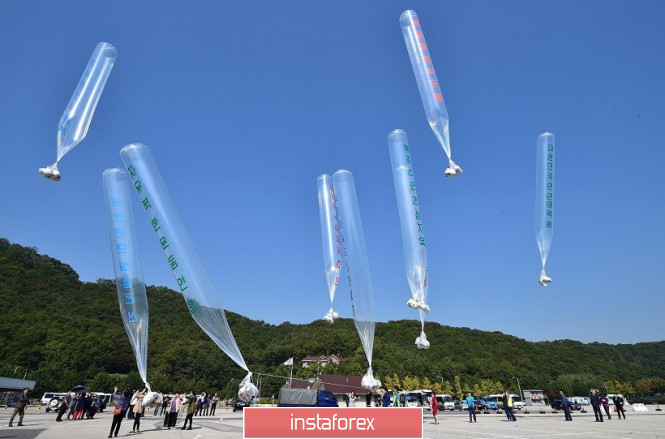The dollar index soared during the end of the trading week, amid general nervousness in the financial markets and increased anti-risk sentiment. The US currency was in demand, although there was no specific reason for avoiding risks - a combination of negative factors played its role. However, after reaching an almost three-week high of 97.660, dollar bulls already retreated - during the Asian session on Monday, the greenback began to gradually lose its position, reflecting the fading of the upward impulse.

This impulse was primarily due to two factors. Firstly, the coronavirus, and secondly, the escalation of conflicts on the Sino-Indian border and on the Korean peninsula. Such fundamental ingredients provoked a surge in anti-risk sentiment. The risk of the second wave of the epidemic is still the number one topic in the world press. Although the situation is gradually improving in Europe, countries such as the United States, Brazil, South Africa and India continue to give alarming signals. Even those countries that formally defeated the epidemic have announced new outbreaks. In particular, South Korea reported nearly fifty new cases of the disease, half of which occurred in Seoul. Twenty five new cases have been recorded in China, most of them also in the capital, Beijing. Both countries have introduced stringent measures to contain the virus, as new outbreaks emerged after easing restrictions. After a three-week pause, Covid-19 reappeared in New Zealand. Several US states reported a record number of infected per day at the end of last week.
Nevertheless, in the context of the foreign exchange market, this fundamental factor over the weekend weakened its influence. This is partly due to the speech of US President Donald Trump, who made it clear that the White House is not going to re-quarantine the country. He linked the growth of identified Covid-19 patients with an increase in the pace of testing Americans for coronavirus. At the same time, according to him, many people did not even realize that they were carriers of the virus, since they had no symptoms. Trump even called for a slowdown in the testing of Americans ("fewer tests - less coronavirus"), but later the White house noted that the president was being ironic. But this position of the head of state eliminated the concern that the United States will decide to re-lockdown. In this regard, the market shows a peculiar cynicism, as traders are not concerned with the increase in the number of cases by themselves, but with the economic consequences of the pandemic.
As for the conflicts on the Sino-Indian border and on the Korean Peninsula, the situation over the past weekend has not worsened. India and China are preparing to sit at the negotiating table - according to some sources, Russia will act as a mediator, and according to other sources, the United States. At the same time, New Delhi and Beijing have already taken certain "friendly steps." India released the Chinese soldiers detained during the conflict in Ladakh, after which China released the Indians. Although the parties accuse each other of violating the agreements reached earlier, they clearly intend to resolve the situation through diplomatic means.
But the situation is clearly more complicated with the Korean Peninsula. Although here (so far) the worst-case scenario, which involves an open military confrontation, has not been realized. North Korea decided to wage an "agitation war" with its southern neighbor. Publishers and printing houses in Pyongyang have printed 12 million propaganda leaflets for distribution in South Korea. Let me remind you that the leaflets with balloons that the South Korean activists distributed in the territory of the DPRK were the direct cause of the escalation of the conflict between the countries. Kim Yo jong, sister of the DPRK leader Kim Jong-un, warned that Pyongyang could use force against the south if Seoul does not stop such a practice. But, as we see, so far Pyongyang has decided to apply only mirror propaganda measures, and this fact has reduced the general degree of intensity.

It is also worth noting that the US dollar grew at the end of last week thanks to Jerome Powell. The head of the Federal Reserve appealed to congressmen with a request to allocate additional funds as part of the anti-crisis program during his speeches. Moreover, Powell personally signed a letter from 150 economists (among whom are his predecessors as the Fed chairman), in which they asked members of Congress to allocate money to stimulate the economy as soon as possible. Let me remind you that the House of Representatives, controlled by the Democrats, has already passed the corresponding bill - but the Republicans and the White House have criticized this document quite severely. This means that the law with a high degree of probability will not be approved by the Senate, and, accordingly, will not be signed by Trump. And although the US treasury secretary announced a new package of economic assistance the week before last, so far things have not gone further than words. Given the proximity of the presidential election, such bills should be viewed through the prism of the election campaigns of Trump and Biden. Therefore, many experts doubt that the above letter, signed by Powell in particular, will speed up the process of approval of this issue.
Thus, the downward dynamics of the dollar index is now fully justified: those fundamental factors that pushed the currency up have now lost (or weakened) their influence. Speaking directly about the euro-dollar pair, here the bulls need to overcome the 1.1215 mark (the middle line of the Bollinger Bands indicator on the daily chart). In this case, it will be possible to consider long positions to the next resistance level - to around 1.1290 (Tenkan-sen line on the same timeframe).
The material has been provided by InstaForex Company - www.instaforex.com